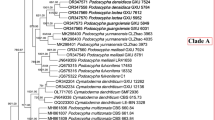Abstract
The chromosome numbers of seven species ofPelargonium sect.Eumorpha have been determined from material of known wild origin, and karyotypic comparisons have been made. Within the section there is variation in basic chromosome number (x = 4, 8, 9, 11), variation in chromosome size, and two species have polyploid races. The three species with chromosome numbers based on x = 11 have the smallest chromosomes (1.0–1.5 µm); chromosomes are larger (1.0–3.0 µm) in the other species.P. elongatum has the lowest chromosome number in the genus (2n = 8).P. alchemilloides is exceptional in that it has four cytotypes, 2n = 16, 18, 34 and 36, and the form with 2n = 36 has large chromosomes (2.0–5.0 µm). Evidence from a synthesized hybrid suggests thatP. alchemilloides with 2n = 16 may be of polyploid origin. The three species based on x = 11 appear to be more closely related to species from other sections ofPelargonium that have the same basic chromosome number and small chromosome size, rather than to other species of sect.Eumorpha.
Similar content being viewed by others
References
Albers, F., van der Walt, J. J. A., 1984: Untersuchungen zur Karyologie und Mikrosporogenese vonPelargonium sect.Pelargonium (Geraniaceae). — Pl. Syst. Evol.147, 177–188.
Daker, M. G., 1969: Chromosome numbers ofPelargonium species and cultivars. — J. Roy. Hort. Soc.94, 346–353.
Friis, I., Gilbert, M. G., 1976:Pelargonium boranense, Ethiopia. — Flowering Plants of Africa43, 1705.
Gibby, M., Westfold, J., 1983: A new basic chromosome number inPelargonium (Geraniaceae). — Caryologia36, 79–82.
Harvey, W. H., 1860:Geraniaceae. — Flora Capensis1.
Jones, K., 1978: Aspects of chromosome evolution in higher plants. — InWoolhouse, H. W., (Ed.): Advances in Botanical Research6, 119–194.
Kokwaro, J. O., 1969: IOPB chromosome number reports. — Taxon18, 684.
- 1971a:Geraniaceae. Flora of Tropical East Africa, pp. 1–25.
—, 1971b: The family “Geraniaceae” in North East Tropical Africa. — Webbia25, 623–669.
Knuth, R., 1912:Geraniaceae. — InEngler, A., (Ed.): Das Pflanzenreich4, 129. — Berlin.
Muller, T., 1963:Geraniaceae. — InExell, A. W., Fernandes, A., Wild, H., (Eds.): Flora Zambesiaca2, 130–149.
Snow, R., 1963: Alcoholic hydrochloric acid-carmine as a stain for chromosomes in squash preparations. — Stain Techn.38, 9–13.
Sweet, R., 1820–1830:Geraniaceae,1–5. — London: James Ridgway, Piccadilly.
van der Walt, J. J. A., 1977: Pelargoniums of Southern Africa1. — Johannesburg, Cape Town: Juta.
—,Vorster, P. J., 1981: Pelargoniums of Southern Africa2. — Johannesburg, Cape Town: Juta.
—, —, 1983: Phytogeography ofPelargonium. — Bothalia14, 517–523.
Author information
Authors and Affiliations
Rights and permissions
About this article
Cite this article
Gibby, M., Westfold, J. A cytological study ofPelargonium sect.Eumorpha (Geraniaceae). Pl Syst Evol 153, 205–222 (1986). https://doi.org/10.1007/BF00983688
Received:
Issue Date:
DOI: https://doi.org/10.1007/BF00983688




